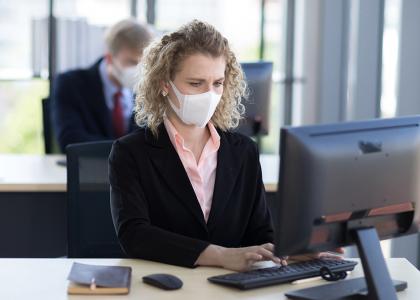Returning to work: the practicalities and challenges

With non-essential shops opening the doors for business this week, it finally looks like we are returning to some level of normality.
However, for many companies the instruction from the government remains the same: your employees should continue to work from home where they can. An announcement is expected on this on 25 June.
In the meantime, there are many things that businesses can be doing to prepare for the return of their employees back into the workplace.
The Practicalities
What does return to work mean for you as an employer? It won’t be just going back to the way things were. Work will look and feel very different.
You will need to make sure that everyone’s safety and wellbeing is protected. This will be different for every company, but there are some common things that all businesses will need to consider.
Risk Assessments
All businesses need to assess and manage the risk of covid-19. As an employer you have a legal duty to protect workers and others to their health and safety. This means assessing all the risks of employees returning to work and taking reasonably practicable steps to reduce these risks. The Health & Safety Executive guidance is:
- To identify what work activity or situations might cause transmission of the virus
- Think about who could be at risk
- Decide how likely it is that someone could be exposed to that risk
- Act to remove the activity or situation, if that isn’t possible, to control the risk
All these steps must have been carefully considered and documented. In addition, you should follow any relevant sector-specific guides produced by the government or approved trade or sector guidance.
The basic rules are, if you can maintain social distancing you should do so. If that’s not possible you can only reopen if you put suitable measures in place to control the risk of transmission. For example, putting barriers in shared spaces.
If you employ 50 people or more, your completed assessment should be published on your website.
It is important you carry out these measures as the Health & Safety Executive will be carrying out spot checks to ensure businesses are keeping employees safe.
Handwashing
One of the key measures in keeping infections at bay is adequate handwashing. With people working from home for such a long period, you should remind them of the importance of this when coming back to work and offering facilities to support this. Notices should be displayed in relevant areas and hand sanitisers should also be provided.
Cleaning
You should keep the workplace clean to minimise the risk of transmission of covid-19. To support this, you should:
- Frequently clean work areas and equipment
- Frequently clear objects and surfaces that are touched regularly
- Ensure workspaces are cleared at the end of the day
- Limit or restrict the use of high-touch items and equipment
- Increase the frequency of cleaning toilets and communal areas
Moving round the business
Some suggestions you could consider for moving round the business and maintaining social distancing are:
- In and out routes and a one-way system
- 2 metre markings
- Allocated desks
- Staggering start and finish times
- Look at staff working in cohorts
The Challenges
After spending so much time at home and being able to control who they have contact with, it is understandable that employees will be concerned about returning to work.
If an employee does not want to attend work because of fears of Coronavirus, you should meet with the individual to understand their concerns and provide reassurance that all reasonable steps have been taken to minimise the risk of infection. If someone refuses to attend work without a valid reason, and if there is no evidence of discrimination, then you could take disciplinary action.
If an employee can’t attend work because of childcare issues, then you should allow a degree of flexibility, such as continuing to work from home or unpaid parental leave.
HR Issues
There are some HR issues you will need to consider when returning to the workplace, including:
- Furlough – you will need to provide a reasonable period of notice when recalling people back into the workplace. If you are not bringing everyone back, you will need to have a selection process about who will return. Be careful not to discriminate and keep a record of how you reached your decision in case you’re asked to defend this.
- Redundancies – if you have to make people redundant, you must follow a fair process and consult with employees in a timely manner. Make sure that your decisions are not discriminatory.
- Changing working patterns – you may need to introduce temporary measures such as staggering start and finish times, if your contracts of employment don’t allow this, then try and reach an agreement with your employees without a formal consultation process. If they object you will have to go down a more formal route. Any changes must be confirmed in writing.
- Whistleblowing – employees who raise concerns about health and safety risks in the workplace which they claim are in the public interest, could exercise whistleblowing rights. If they put their concerns in writing that could be considered a protective disclosure against health and safety concerns.


